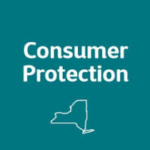August 26 was Women’s Equality Day, A Day to Raise Awareness of Gender Inequalities and an Opportunity to Help Reduce the Gender Pricing Gap
Secretary of State, Robert J. Rodriguez, “New York’s Gender Price Equity Law Means “Pink or Blue” Should Not Matter”
In honor of Women’s Equality Day, the New York State Division of Consumer Protection (DCP) reminds consumers that gender-based pricing of consumer services and products, also known as “pink tax,” is illegal in New York State. Gender-based pricing is the practice of charging different prices for substantially similar goods or services marketed to women. Gender-based pricing has been a long-standing problem but as of 2020, the practice has been prohibited within the state and we hope to increase awareness of these disparities and call greater attention to the work that still needs to be done.
 “Women’s Equality Day is a day to raise awareness of inequalities and a great opportunity to increase consumers’ awareness of gender-based pricing, as well as to explain to businesses how they can eliminate these practices for a more equitable marketplace,” said Secretary of State Robert Rodriguez, who oversees the Division of Consumer Protection. “New York’s Gender Price Equity Law means “pink or blue” should not matter. We’ve come a long way, and despite the great strides made in advancing women’s opportunities, these pricing inequities continue to impact women’s progress.”
“Women’s Equality Day is a day to raise awareness of inequalities and a great opportunity to increase consumers’ awareness of gender-based pricing, as well as to explain to businesses how they can eliminate these practices for a more equitable marketplace,” said Secretary of State Robert Rodriguez, who oversees the Division of Consumer Protection. “New York’s Gender Price Equity Law means “pink or blue” should not matter. We’ve come a long way, and despite the great strides made in advancing women’s opportunities, these pricing inequities continue to impact women’s progress.”
The “pink tax” forces women to spend more on everyday necessities. These price differences add to their economic burden and impacts their ability to save money for the future. Women are already paid less than men, about 83 cents for every dollar a man makes, which limits their resources. Not only do these unfair practices impact the amount of money they have on a daily or weekly basis, but paying more over a lifetime can have sweeping implications for women’s finances.
TIPS TO HELP REDUCE THE GENDER PRICING GAP:
- Get savvy about the “pink tax.” The best thing New Yorkers can do, is to increase your knowledge of it and pay attention to price differences. According to a study produced by the New York City Department of Consumer Affairs, common “pink tax’ items include personal care products, clothing, children’s toys, services (dry cleaners, self-care services, hair salons, vehicle repair), and home health care products.
- Price compare when shopping. Most products or services are identical or have only slight variations, so check to see if the item or service is also marketed to men and if it’s cheaper. If you see this pricing gap, use your voice to report the apparent violation of law and opt for the less expensive option. It’s important to be a strategic consumer and be aware of these price differences.
- Read product labels carefully. When buying a product, check for details in each product to see if there is any difference between the gendered options. Some areas to look at include differences in active ingredients, product features, material or unit size.
- Pay attention to the price list of services. When shopping for services, consumers are entitled to receive a complete written price list, upon request, from any person or business providing consumer services that are used, bought or rendered primarily for personal, family or household purposes.
- Understand when to accept the extra cost: The law generally makes it unlawful for a business to charge different prices for a service (e.g., haircut) or product (e.g., hair gel) unless there is a gender-neutral reason. Some factors businesses can consider include, but are not limited to:
- the amount of time it took to provide such services;
- the difficulty offering such services;
- the cost incurred in offering such services;
- the labor used in providing such services;
- the materials used in providing such services.
- Consider buying gender-neutral items like toys, soap, razors, deodorant, and shampoo that don’t really need to have two versions — one for men, one for women.
- File a complaint If you encounter gender-based pricing. Report any violations to the New York State Division of Consumer Protection.
- For more examples of shopping scenarios, please review the December 2020 Consumer Alert.
GUIDANCE FOR NYS BUSINESSES:
New York State businesses can help eliminate gender-based pricing in order to comply with New York State law by reviewing the Department of State gender-neutral pricing guidance that was issued in October 2020. The purpose of this guidance is to help businesses licensed by the Department understand how to comply with the law. Businesses are encouraged, but not required, to update business signs to reflect any fees listed are determined based on the service provided and not a client’s gender.
In New York State, the New York State Attorney General has authority to enforce these laws and the Division of Consumer Protection is charged with assisting aggrieved consumers in the marketplace. When issues arise with New York State merchants charging different prices based on gender, consumers are encouraged to:
- File a complaint with DCP, if the consumer has purchased an inequitably gender priced item, to seek return of the difference between the higher priced and lower priced gender marketed item or service paid to a New York State merchant.
- File a complaint with the Attorney General to enforce the law against a specific merchant you believe to have violated the law.
Consumers can best support their complaints by submitting evidence of noncompliance, which may include pictures of the advertised items and prices, purchase receipts, and merchant’s location details.
The New York State Division of Consumer Protection provides voluntary mediation, between a consumer and business, when a consumer has been unsuccessful at reaching a resolution on their own. The Consumer Assistance Helpline 1-800-697-1220 is available Monday to Friday from 8:30 a.m. to 4:30 p.m., excluding State Holidays, and consumer complaints can be filed at any time at www.dos.ny.gov/consumer-protection. To view consumer alerts, consumers can visit here. The Division can also be reached via Twitter at @NYSConsumer or Facebook at www.facebook.com/nysconsumer









